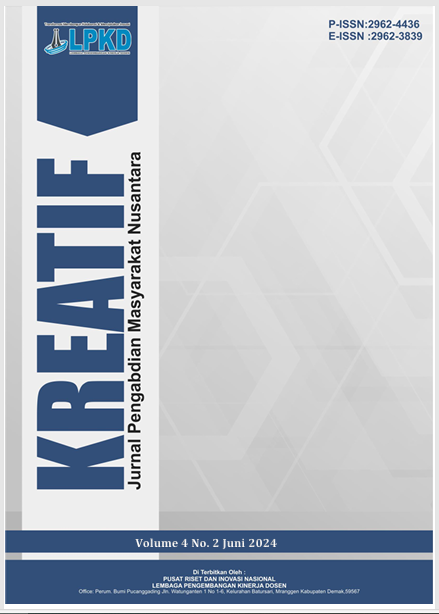Kegiatan Pengabdian Masyarakat Dengan Penilaian Rasio Apolipoprotein A Dan B Dalam Memantau Risiko Penyakit Jantung Pada Lansia
DOI:
https://doi.org/10.55606/kreatif.v4i2.3390Keywords:
Apolipoprotein, Health Education, Elderly, Heart DiseaseAbstract
Coronary heart disease is a serious medical condition characterized by narrowing or blockage of the coronary arteries, leading to decreased blood flow to the heart and a high risk of causing chest pain, shortness of breath, fatigue and heart attack. In the elderly, coronary heart disease can worsen the quality of life and increase morbidity and mortality rates. The importance of health education and screening for apolipoprotein A (ApoA) and B (ApoB) in the elderly is crucial because the ApoA/ApoB ratio is an important indicator in monitoring the risk of heart disease. This community service activity aims to screen the ApoA/ApoB ratio as an indicator in monitoring the risk of heart disease in the elderly. With the PDCA (Plan-Do-Check-Act) approach, outreach, blood sampling, health education and evaluation of results are carried out to provide specific health recommendations. Screening results showed variations in the distribution of the ApoA/ApoB ratio between genders, emphasizing the importance of routine monitoring and healthy lifestyle interventions to prevent heart disease and improve the quality of life of the elderly.
References
Ahuja, R., et al. (2018). Public awareness of health-related risks from uncontrolled hypertension. Preventing Chronic Disease, 15(4), 6–11. https://doi.org/10.5888/pcd15.170362
Chapman, M. J. (2011). Pitavastatin: Novel effects on lipid parameters. Atherosclerosis Supplements, 12(3), 277–284. https://doi.org/10.1016/S1567-5688(11)70887-X
Destra, E., & Firmansyah, Y. (2022). Intervention Program in Effort to Reduce New Cases. Jurnal Pengabdian Mandiri, 1(5), 677–682.
Ernawati, E., et al. (2023). Pengaruh Kadar Profil Lipid, Asam Urat, Indeks Massa Tubuh, Tekanan Darah, dan Kadar Gula Darah Terhadap Penurunan Kapasitas Vital Paru pada Pekerja Usia Produktif. Malahayati Nursing Journal, 5(8), 2679–2692. https://doi.org/10.33024/mnj.v5i8.10414
Feingold, K. R. (2000). Obesity and Dyslipidemia. In Endotext.
Giammanco, A., et al. (2023). APOC-III: a Gatekeeper in Controlling Triglyceride Metabolism. Current Atherosclerosis Reports, 25(3), 67–76. https://doi.org/10.1007/s11883-023-01080-8
Hill, M. F., & Bordoni, B. (2024). Hyperlipidemia. In StatPearls. http://www.ncbi.nlm.nih.gov/pubmed/5568160
Kissebah, A. H., Alfarsi, S., & Adams, P. W. (1981). Integrated regulation of very low density lipoprotein triglyceride and apolipoprotein-B kinetics in man: Normolipemic subjects, familial hypertriglyceridemia and familial combined hyperlipidemia. Metabolism, 30(9), 856–868. https://doi.org/10.1016/0026-0495(81)90064-0
Koch, M., et al. (2020). High density lipoprotein and its apolipoprotein-defined subspecies and risk of dementia. Journal of Lipid Research, 61(3), 445–454. https://doi.org/10.1194/jlr.P119000473
Li, Y. H., et al. (2017). 2017 Taiwan lipid guidelines for high risk patients. Journal of the Formosan Medical Association, 116(4), 217–248. https://doi.org/10.1016/j.jfma.2016.11.013
Linton, M. F., et al.. (2019). The Role of Lipids and Lipoproteins in Atherosclerosis. Science, 111(2877), 166–186.
Masenga, S. K., & Kirabo, A. (2023). Hypertensive heart disease: risk factors, complications and mechanisms. Frontiers in Cardiovascular Medicine, 10(June), 1–16. https://doi.org/10.3389/fcvm.2023.1205475
Page, M. M., et al. (2016). Anacetrapib for the treatment of dyslipidaemia: The last bastion of the cholesteryl ester transfer protein inhibitors? Expert Opinion on Pharmacotherapy, 17(2), 275–281. https://doi.org/10.1517/14656566.2016.1129402
Parhofer, K. G. (2022). New targets for treating hypertriglyceridemia. Current Opinion in Endocrinology, Diabetes and Obesity, 29(2), 106–111. https://doi.org/10.1097/MED.0000000000000714
Pol, T., et al. (2018). Dyslipidemia and risk of cardiovascular events in patients with atrial fibrillation treated with oral anticoagulation therapy: Insights from the ARISTOTLE (Apixaban for Reduction in Stroke and Other Thromboembolic Events in Atrial Fibrillation) trial. Journal of the American Heart Association, 7(3), 1–11. https://doi.org/10.1161/JAHA.117.007444
Richardson, T. G., et al. (2020). Evaluating the relationship between circulating lipoprotein lipids and apolipoproteins with risk of coronary heart disease: A multivariable Mendelian randomisation analysis. PLoS Medicine, 17(3). https://doi.org/10.1371/JOURNAL.PMED.1003062
Ruslim, D., et al. (2023). Pengaruh Kadar High Density Lipoprotein (HDL) dan Usia terhadap Kejadian Peripheral Arterial Disease (PAD). Termometer: Jurnal Ilmiah Ilmu Kesehatan Dan Kedokteran, 1(3), 180–190. https://doi.org/10.55606/TERMOMETER.V1I3.2059
Singh, K., & Prabhakaran, D. (2024). Apolipoprotein B - An ideal biomarker for atherosclerosis? Suppl 1, S121–S129.
Sniderman, A., et al. (2010). Why is non - High-density lipoprotein cholesterol a better marker of the risk of vascular disease than low-density lipoprotein cholesterol? Journal of Clinical Lipidology, 4(3), 152–155. https://doi.org/10.1016/j.jacl.2010.03.005
Virani, S. S., et al. (2011). Relation of cholesterol and lipoprotein parameters with carotid artery plaque characteristics: The Atherosclerosis Risk in Communities (ARIC) carotid MRI study. Atherosclerosis, 219(2), 596–602. https://doi.org/10.1016/j.atherosclerosis.2011.08.001
Downloads
Published
How to Cite
Issue
Section
License
Copyright (c) 2024 Welly Hartono Ruslim, Raden Seliwat Agung Aditya, Chandy Linardi Putra

This work is licensed under a Creative Commons Attribution-ShareAlike 4.0 International License.








